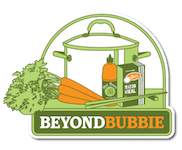Grandma Sylvia always advised me, “If you can read, you can cook.” Her mother died when she was very young and she was raised by her father, so when she married Grandpa Alex, she’d never learned to so much as boil an egg. After her wedding, she came home and cracked open her newly purchased Joy of Cooking, and the rest was history. Over fifty years of marriage, and even to the end of his life when cancer curbed his appetite, my grandfather refused to leave even a morsel of Grandma’s cooking — from anyone’s plate — uneaten. Although the reason may have been Grandpa’s Depression era mentality, I prefer to think it was because the cooking was so delicious.
In the kitchen of their Bethesda, Maryland house which I visited every Friday throughout my childhood, the dishwasher was Grandpa’s domain as he had a highly complex loading strategy which we all tried and failed to grasp. Everything else in that narrow, formica-covered space with the mushroom-patterned wallpaper, however, was Grandma’s turf. One of her specialties which I have searched for ever since, to no avail, was a big heaping dish of little fried, salty, whole fish called smelts. How she managed to get a 5-year-old to gobble down plates of whole fish, with the dead eyes staring out at you, is even more of a mystery to me now that I’m a parent of two picky eaters.
Like so many Bubbes, Grandma single-handedly prepared Passover dinners for a dozen hungry mouths with barely so much as a sit-down. But I don’t believe any other Bubbe in the world ended a Seder with her particular party trick. Once the plates were cleared and put into the dishwasher according to Grandpa’s incomprehensible mathematical algorithm, my grandmother would finally collapse at the table, pull off her apron, and roll back her sleeve. From there I can only describe what she did from the perspective of the child I was — My grandmother became a female, Jewish Popeye. With her palm placed lightly on her forehead, her bicep flexed, she then proceeded to pop and bounce her exceedingly large arm muscle in a staccato rhythm so that it danced like a Mexican jumping bean. This was a crowd pleaser for the whole family, and the grandchildren were left to wonder what made their Grandma so well-endowed in the bicep area. Maybe it was her cooking.
Ingredients:
1 lb Lean, raw beef chopped (i.e. hamburger meat), salted and peppered
2 Large Onions 1 chopped fine, 2nd onion chopped medium
2 Cup(s)s Rice cooked (1 cup cooked rice to put in stuffing, prepare 2nd cup cooked rice to accompany servings of holupchus)
1 tablespoon Water
1 Eggs slightly beaten
1 whole Cabbage (one head)
2 Cup(s)s Tomatoes canned, broken up a bit so that tomatoes aren’t whole
1 tablespoon Matzah meal optional
1/2 cup(s) Golden raisins or to taste
4-6 Tablespoons Dried mint or to taste
Pinon nuts optional; to taste
1 tablespoon Honey or more; to taste
Several pinch Ginger
2 Tablespoons Brown sugar or more; to taste
1 Lemon (juice of 1 lemon)
Preparation:
Boil enough water in a large pot to cover about 2/3 of the cabbage head, the goal being to steam it and soften the leaves. Put cabbage in and cover pot. Pull off outer leaves as they soften. This will probably have to be repeated several times as you work towards the middle. All leaves should be soft enough to fold but not overcooked. This is best to do a little ahead so that the cabbage cools enough to work with.
Mix together the raw beef, 1 onion chopped fine (save the other onion for later), 1 cup cooked rice (prepare and save the 2nd cup rice to serve with the holupchus), the tablespoon of water, the egg, and the optional matzah meal. Roll up the meat mixture into small balls for filling little cabbage leaf packages that should be folded up like envelopes, open side down.
When all cabbage rolls have been put into a large pot, put in on top the tomatoes, the second onion (chopped into medium sized chunks), the honey, the ginger, the brown sugar, and the juice of one lemon.
Cover and simmer on low heat 1 hour – 1 1/2 hours approximately, tasting as you go.
Serve the holupchus with the cup of cooked rice. You can prepare more rice to accompany this if you want to serve the holupchus as a main course rather than as an appetizer.
Enjoy the sweet and sour goodness!















